

|
|
 |
|
|
| > Marvel Masterworks Library |
|
Click panels for larger images _________________________ 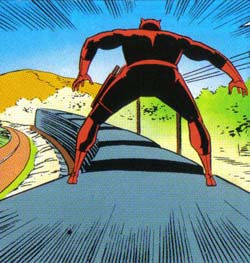
(Click panels for larger images.) _________________________ 
THE DAREDEVIL RESOURCE
MAN WITHOUT FEAR
DAREDEVIL: DIRECTOR'S CUT DVD
DAREDEVIL: WIDESCREEN EDITION DVD PRINT HISTORY &
Original 27
_________________________
ComicCraft
_________________________
Barnes & Noble Softcover
|

Marvel Masterworks: Daredevil Volume 1 Reprints: Daredevil #1-11 (Vol. 17 in the Marvel Masterworks Library)
Current In-Print Edition: 2nd Edition, First Print
REGULAR EDITION ISBN: 0-7851-1257-X • List Price: $49.99 256 Pages
Scripted by Stan Lee and Wallace Wood
Buy From: "Here comes....DAREDEVIL!" Yep, there he came, alright...the Man Without Fear! In a bid to cross-market their new costumed hero to the comics-reading kids and young adults of America, Marvel tried on the cover of Daredevil #1 to pull in fans of Spider-Man and Fantastic Four, declaring the Daredevil as a "worthy companion" and continuer of "tradition" that Marvel Maniacs had come to expect from the burgeoning new company. But in case fans were thinking, "Oh great! Marvel's offering more of the same," they seeded the cover to Daredevil #1 with the evocative question "Can you guess why Daredevil is different from all other crime-fighters?" Looking back at the timeline of Silver Age Marvel output, it's interesting to note that up until that point, when Daredevil premiered in April 1964, he starred in only the third non-team superhero comic in the Marvel stable to not share billing in an anthology title. After the Hulk and Spider-Man..."here comes Daredevil!" Hulk was obviously a monstrous anti-hero, and Spider-Man was a city-swingin' kid super-hero. Daredevil bore a large resemblance to Spidey in stature and skills, but as the question asked, how was he different? Well, the credo at Marvel was to create super-powerful heroes with amazing skills, but to humanize them with frailties and imperfections that made them seem more down-to-earth and relatable. Spidey was a naive and under-pressure teenager. The Hulk was a Jekyll/Hyde creature of atomic rage. Thor's alter-ego was lame and Iron Man had a terrible heart condition! (And Ant-Man had the Wasp!!!) But Daredevil, I think we can all agree, had a frailty that was probably Stan Lee's blockbuster of them all.... Daredevil was blind, y'see.... Yep. Blind. The guy couldn't see. Just like any blind person, Matt Murdock walked with a cane, fumbled around in the room in broad daylight, read Braille...but unlike other sightless people, the accident that caused his blindness (a nasty run-in with a radioactive isotope) gave him a set of heightened senses far beyond any normal man- smell, taste, touch and hearing, all operating at peak capacity, and helping to formulate a "radar sense" that acted in many ways better than real sight. Daredevil could "see" the outline of people and things in the room with him, he could "hear" them from across the city, he could pick up incredibly complex details through his senses of smell and taste that no other person could approach. Add to that peerless athletic ability and you have a new super-hero! Unfortunately, Daredevil had to fight over twenty years to achieve the same kind of regard fandom held for Spider-Man, his fellow New York crime-fighter. The two were similarly matched in their overall sense of purpose: to live and do good in New York City, protecting the average guy from day-to-day criminal menaces like the Owl and the Kingpin, while the FF and Avengers were off stopping Galactus and Kang from blowing up the Marvel Universe with their little pinkie fingers. Daredevil was bi-monthly for nearly the first two years of his existence, and proved to be a second-tier comic through the sixties and seventies until Frank Miller arrived and bumped the comics world on the noggin with a run that hasn't been paralleled by many other comics in the artform, let alone Daredevil! That's not to say Daredevil doesn't have its virtues. No way! There's a lot of gems to be found here, and this first volume showcases the height of "comics artiste" of excellence Wally Wood's biggest contribution to Marvel Comics. His run, starting in issue five and concluding in issue eleven, shows off a lush and sweetly rendered Daredevil. Daredevil's action poses are strong and supple, with Wally Wood putting a lot of Pop-Art pop into the blind acrobat, having him leap off the precipice of a rooftop or swing around the city canyons tethered only to his billy club cord, a dextrous daredevil of derring-do. Wood's showcase issue has to be Daredevil #7, which pits Namor, the avenging son of Atlantis, against our blind hero. Stan Lee scripts his story making no excuses for putting one of the Marvel Universe's most powerful hombres up against a newly-minted blind guy with no super-strength. In fact, Daredevil loses this battle, but he proves in the dramatic action sequence that is the book's climax that there is more to his character profile than super-strength or super-powers; that there's more than one way to win a battle than to beat your opponent into submission. And that's where the real story of Daredevil is being told! Throw in the great battle sequence between Namor and DD, an oddball plotline and one of Silver Age Marvel's finest splash pages, and Daredevil #7 is one of the greats of Marvel comics history. Not to be overlooked is the two-part Organization storyline that concludes Daredevil Masterworks Vol. 1, in which Wally and Stan plot their way to a detective thriller where DD sleuths his way to getting his man, and Wally turns in one of my personal favorite covers of the Marvel Age in Daredevil #10. Wally Wood's Cat Man and Ape Man, particularly, are what the joy of Marvel Comics is all about...I just love those character renderings! Bill Everett's excellent origin story in Daredevil #1 can't be dismissed either, with yet another "super-powers by radioactivity plotline" being one of the least important parts of the story. Far more important to Daredevil than being blasted with a canister of radioactive isotope are these plotpoints: a young man coping with the expectations of a single father, the inevitable conflict between using your brain and using your brawn, coping with a disability and the search for justice in an imperfect nation of laws. All these tangents are touched on in a "kid's comic" with dignity by Stan Lee and his team of co-creators. This volume also features the introduction of a few mainstay Daredevil villains, like the Owl, Killgrave, Stilt-Man and Mister Fear, as well as the long-time supporting cast of law partner Franklin "Foggy" Nelson and their lovely secretary Karen Page. An interesting counterpoint to the usual dynamic of the "hero pursuing the girl" subplot that was working similarly in Spider-Man, Thor and a plethora of DC comics is that Matt Murdock was pursuing Karen Page simultaneously as his best buddy and main supporting cast-member, Foggy Nelson. The resultant love triangle was something that Marvel's youngest fans might not have been ready for, but it's darned well what they got. (For a modern take on the early days of Daredevil, especially his love affair with Karen Page, check out Jeph Loeb and Tim Sale's DAREDEVIL: YELLOW, a luxuriously illustrated book that is inspired by these very stories.) But I cannot let this feature page essay pass without the mention of one of my favorite Marvel comics of all time. Note, I did not say "best"...I said "favorite!" I speak of Daredevil #5, in which the Man Without Fear battles the Mysterious Masked Matador! This is a comic that is so bad, it's not merely good, it's great! It's Wally Wood's debut issue, and he does an able job articulating what has to be one of Stan Lee's silliest villain conceits. The Matador is such a poor example of a super-villain, such a woefully conceived nemesis, that Stan has to create non-sequiter situations out of thin air that allow the Matador to escape from Daredevil merely so they can fill out 20 pages! I could go on about this particular comic, but the joys and revelations of it should be yours to behold without being hindered by any more spoilers. Just take it from me, you'll be howling with laughter or I'll buy you a burglar alarm! -- by Gormuu -- panel images provided by Avengers Assemble
Issues Reprinted Click on cover image to learn more about each issue. |
|||||||
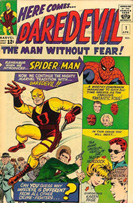 DD #1
DD #1 |
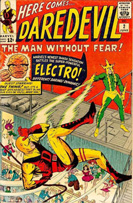 DD #2
DD #2 |
 DD #3
DD #3 |
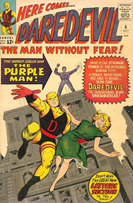 DD #4
DD #4 |
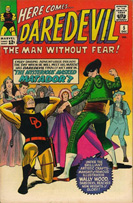 DD #5
DD #5 |
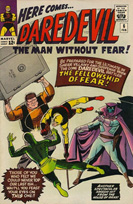 DD #6
DD #6 |
|||
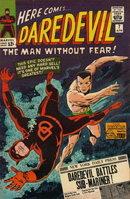 DD #7
DD #7 |
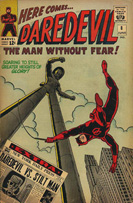 DD #8
DD #8 |
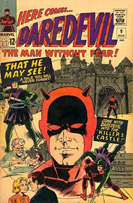 DD #9
DD #9 |
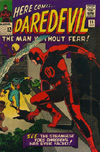 DD #10
DD #10 |
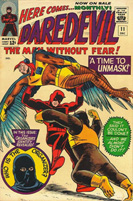 DD #11
DD #11 |
||||
|
All cover images are courtesy of the Silver Age Marvel Comics Cover Gallery. Website design by Doug Roberts and John Thomas. All images on this site are copyright of Marvel Comics. This site is for reference purposes and promotion of the Masterworks line of books as well as Marvel Comics and their properties. |
||||||||
|
Reader Reviews and Commentary To contribute: Send to Gormuu! Submit only with understanding your text may be edited by gormuu for space, content and syntax/grammar considerations! |